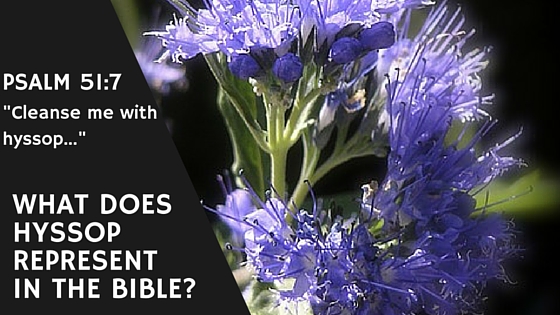
Key Bible Verse: Psalm 51:7,“Purge me with hyssop and I shall be clean; wash me, and I shall be whiter than snow.”
Psalm 51 is David’s prayer of repentance after he sins with Bathsheba. Within this prayer, David expresses his supreme confidence in the the faithfulness of God to forgive. However, when we come to Psalm 51:7, David mentions a plant called “hyssop.” It seems like an odd request to ask God to use a hyssop plant to wipe away David’s sin. So it raises a question worth asking, “What does the hyssop represent in the Bible?”
What Does the Hyssop Represent in the Bible? The Hyssop Was a Means of Transferring the Blood of the Sacrifice to the Sinner
In Psalm 51:7, David is expressing his confidence in God’s power to restore him. One definition of the word “purge” is: to rid someone of an unwanted feeling, memory, or condition, typically giving a sense of a physiological and emotional release. “Purge” is a verb, meaning it is an action that David is requesting God to actually do to him. The NIV translates Psalm 51:7 as, “Cleanse me with the hyssop, and I will be clean; wash me, and I will be whiter than snow.”
Now what the heck is this “hyssop” all about Psalm 51:7? To really appreciate what David is saying, you have to understand the significance of the hyssop branch in Old Testament. In Exodus 12:22 the hyssop is used at the first Passover to spread the blood around the door frames. In Leviticus 14:4-7 the hyssop and the blood are used in the ceremonial cleansing of the leper. In Numbers 19:1 hyssop is used for cleansing someone who has touched a dead body.
Basically the hyssop branch is a means by which the blood of the sacrifice was transferred to the sinner.
What Does the Hyssop Represent in the Bible? The Hyssop Points to the Substitutionary Atoning Death of Jesus Christ
The hyssop branch, however, shows up in the New Testament as well, right at the crucifixion of Jesus. John 19:28-30 explains:
After this, Jesus, knowing that all was now finished, said (to fulfill the Scripture), “I thirst.” A jar full of sour wine stood there, so they put a sponge full of the sour wine on a hyssop branch and held it to his mouth. When Jesus had received the sour wine, he said, “It is finished,” and he bowed his head and gave up his spirit.”
It’s crazy how much symbolism is going on here. Jesus is drinking the wine vinegar. Psalm 75:8 states, “For in the hand of the LORD there is a cup with foaming wine, well mixed, and he pours out from it, and all the wicked of the earth shall drain it down to the dregs.” Jesus prayed in Matthew 26:42 (NIV), “My Father, if it is not possible for this cup to be taken away unless I drink it, may your will be done.” Therefore it’s safe to conclude that the cup of sour wine Jesus drinks at the crucifixion is representing the cup of God’s wrath which we all deserve to drink because of our sins. The cup could be taken away from Jesus even if he didn’t drink it. But the cup of God’s wrath could not be taken away from us unless Jesus drank it on our behalf.
Notice, however, that this wine representing God’s wrath was transferred to Jesus on the hyssop branch. The hyssop plant and the wine vinegar are symbolizing the substitutionary death of Jesus on our behalf. Jesus died in our place. Jesus drank the cup of God’s wrath that we were supposed to drink. And it was as if God ordained the hyssop branch to show up right at the crucifixion to remind everyone who was watching that all those symbolic rituals in the Old Testament were symbolizing this moment.
It’s like God was saying to everyone, “It wasn’t the blood of the lamb spread of your door frame with the hyssop that allowed the angel of death to pass over you when you were leaving Egypt. It wasn’t the blood of animals that Moses sprinkled on you with the hyssop that appeased my wrath. It was my Son’s blood. I did that. I lead you out of Egypt. I paid the price for your rebellion. Look at the hyssop and remember my son. Look at this Old Testament symbol and now look at the one it was symbolizing.”
What Does the Hyssop Represent in the Bible? The Hyssop Represents the Freedom and Forgiveness of the Gospel
David may have not fully understood what he was saying, but when he prayed in Psalm 51:7 that God would “purge me with the hyssop,” it was if he was praying that God would release him of the judicial, emotional, physical, and spiritual burden he was under because of his sin.
When we see what the hyssop is representing in the Bible, we can read Psalm 51:7 with the understanding, “Cleanse me with Jesus’ blood and I will be clean, wash me with his blood, and I will be whiter than snow.”